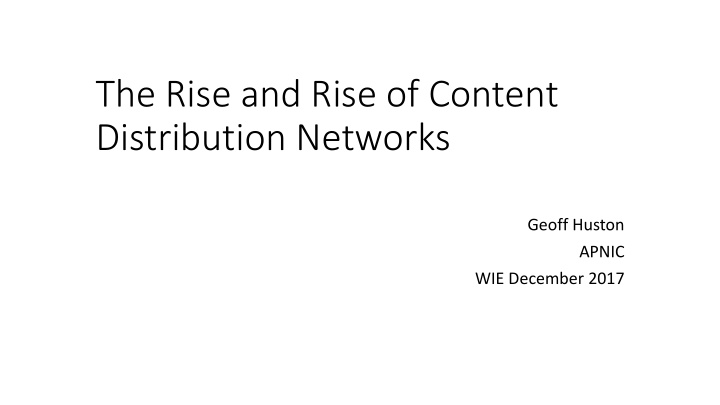



The Rise and Rise of Content Distribution Networks Geoff Huston APNIC WIE December 2017
Our Heritage Our Heritage The Telephone Network: • Connected handset to handset • Intentionally transparent network • Peer-to-peer service construct • Network-centric architecture with minimal functionality in the edge devices
Computer Networks Computer Networks The original concept for computer networks was like the telephone network: • The network was there to enable connected computers to exchange data • All connected computers were able to initiate or receive “calls” • A connected computer could not call ”the network” – the network was an invisible common substrate • It made no difference if the network had active or passive internal elements 3
Clients and Servers • The rise of the web-based content publishing model was accompanied by the creation of specialised server computers that published data, and specialised client-side devices who could only retrieve published data • The rise of NATs enforced this role segmentation in the network • And, coincidentally removed any sense of urgency associated with the transition to IPv6
Content Server Content Server 5
The Tyranny of Distance But not all clients enjoy the same experience from a single service portal Facebook presentation at NANOG 68
Content Distribution Content Distribution Network 7
Let them eat data! The rise of the Content Distribution Network • Replicate content caches close to large user populations • The challenge of delivering many replicant service requests over high delay network paths is replaced by the task of updating a set of local caches by the content distribution system and then serving user service requests over the access network • Reduced service latency, increased service resilience, happy customers!
Role Reversal Service portals are increasingly located adjacent to users And that means changes to the network: • Public Networks no longer carry users’ traffic to/from service portals via ISP carriage services • Instead, Private Networks carry content to service portals via CDN services This shift has some profound implications for the Internet 9
Does Transit have a Future? We see the CDN systems reserve a carriage resource through dedicated bandwidth / wavelength / cable purchase and effectively bypass the open IP carriage infrastructure 10
Does Transit have a Future? • If users don ’ t send packets to users any more… • If content is now delivered via CDNs to users via discrete service cones… • If there is no universal service obligation for content… • If there is no visible definition of the “Internet Route Set” (‘default’) any more… • If there is no economically viable demand for transit any more… Then why do we still need Transit Service providers?
Exactly where are we? • We started this journey building a telephone network for computers to communicate between each other • But now one-way content distribution lies at the core of today’s Internet • This content distribution role is an enterprise service framework rather than a public carriage service • The internal parts of the carriage network are now being privatized and removed from public regulatory scrutiny • What’s left is just the last mile 12
Last Mile Futures • Can independent last mile access networks survive as independent entities in this environment? • Like the experience with transit markets will they fall victim to the pressure from the cashed up service provider sector and their CDNs? • If access networks come to rely on imposing tolls on content providers, then at what point will the folk paying the these tolls assert proprietorial control over this last mile asset? • Is this something that markets will resolve, or will we see this as a more insidious form of market failure?
Fin!
Recommend
More recommend